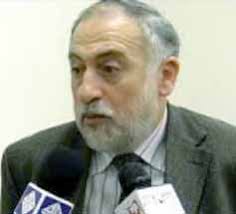26 November 2018
Interview with...Vittorio Amedeo Cicogna, Direttore U.O.C. Risk Management Azienda USL ROMA 6
Direttore U.O.C. Risk Management Azienda USL ROMA 6
[Cleared n°9 - anno XV - october 2018]
Direttore U.O.C. Risk Management Azienda USL ROMA 6
[Cleared n°9 - anno XV - october 2018]

Mr. Cicogna, what is your role within the LHA and why is the role of Risk Manager important in Healthcare?
For about two years now, I have held the position of Risk Manager in the Rome 6 Local Health Authority, which covers an area of 21 municipalities in the Castelli Romani and along the Lazio coast, with a total population of over half a million; the Authority has about 3500 employees, including doctors and other professional staff working in seven directly-managed hospitals and in a number of local specialist facilities. For about 15 years I held the position of Chief Medical Officer in LHAs in various Italian regions including Lazio. The role of Healthcare Risk Manager is required under specific laws and over the years it has gained increasing importance in the prevention of clinical risk, relating to possible errors in medical treatment and to the reduction of costs resulting from litigation brought by users against the medical organisations and staff.
What are the main characteristics and skills that a Risk Manager must have?
A Risk Manager in a healthcare institution needs to be a physician with experience in public health disciplines and must have expertise in medical law, corporate management and health legislation in addition to normal clinical skills. He/She needs to have knowledge of production processes and be able to grasp relevant issues and maintain ongoing relations with the various levels of the organisation. He/She needs to interface with healthcare staff, establishing a climate of trust so that they will be willing to provide spontaneous reports on any critical events they become aware of.
Can you describe the similarities, or differences between clinical risks and aeronautical risks?
Clinical risk exists in all healthcare activities, including diagnosis and medical treatment. A patient may very often suffer harm as a result of medical treatment. Often the mistake goes unnoticed and only emerges in particularly striking circumstances. The likelihood of mistakes being made is partly the result of individual conduct, but more often due to serious organisational issues. The two systems, Public Healthcare and Aviation, use common tools for risk prevention and analysis, such as checklists, incident reporting, organisational audits, protocols and procedures.
How did you have initial contact with ENAV and what are the main aspects of your collaboration with it?
The Risk Management Operative Unit organises training courses every year for the LHA's healthcare staff in order to spread the culture of safety, illustrate what tools are available to prevent risks, and to reduce adverse events and claims for damages that may be filed by those who believe they have suffered harm. The Training Plan for the current year also involves experts from ENAV so as to enable our staff to learn about the tools that other Organisations use in the prevention and management of risks and the extent of their sphere of operation. The chance to meet and share information, as a result of this decision, has aroused considerable interest among participants.
ENAV has always been committed to keeping safety as a major priority. In your view, in what areas might there be room for improvements in the prevention of aviation risk?
Improvements in safety standards can only be achieved through a sound policy in the management of human and technological resources both in healthcare and other types of institutions. Insufficient staffing levels, stress due to excessive work shifts, internal conflict and the application of resource quotas allocated to the modernization and upgrading of assets, all provide strong evidence that error risks may occur within an organisation.
Is Clinical risk management, or Risk Management, in conflict with the business that each LHA pursues?
Risk management allows the LHA to achieve significant savings both in treatment costs and in costs for litigation in healthcare cases. Medical staff often make diagnostic and therapeutic choices that are not exactly appropriate for the health needs of the patients with the sole aim of avoiding possible claims for damages. This operating procedure, known as “defensive medicine”, leads to enormous and unjustified costs for the System.


